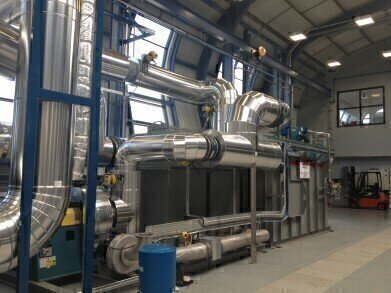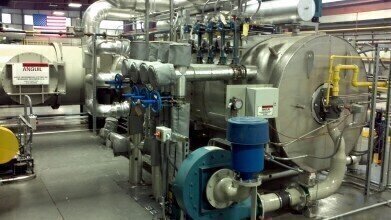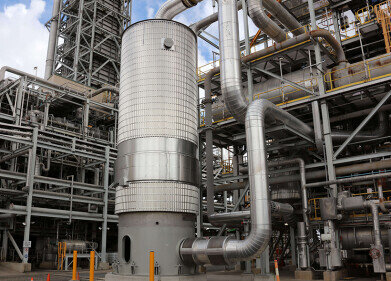Air Clean Up
Two Carbon Fibre Facilities Revolutionise the Manufacturing Process While Setting New Standards for Environmental Stewardship
Oct 04 2013
As a material, carbon fibre has fundamentally changed many of the products we use every day, making them lighter, stronger and more durable. The manufacturing process is typically unique to each supplier and it can be as complex as the fibre molecules themselves. Equally as challenging are the air pollution control systems used on the production equipment. This year, two institutions on opposite sides of the world have rolled out new processing techniques that utilise different, yet highly effective air pollution abatement technologies that also drive down production costs.
When the first conversion plants came online, operating costs were not critical design parameters and neither were the environmental effects of production. Today, the manufacturing of carbon fibre is heavily regulated by the environmental community and producers are continually looking to reduce energy demands of this heat intensive process. The oxidation and carbonisation furnaces and industrial ovens have the potential to emit hydrogen cyanide (HCN), ammonia (NH3) and volatile organic compounds (VOCs). Some of these pollutants are immediately dangerous to human health, even in very small quantities. Other pollutants of concern for carbon fibre producers include Greenhouse gases (GHGs) such as carbon monoxide (CO) and nitrogen oxide (NOX). These emissions not only contribute to global warming but also have a direct correlation with the manufacturer’s consumption of energy.
Recycling at the Forefront in the United Kingdom
The strength, durability and light-weight characteristics of carbon fibre make it perfect for many manufactured products like airplanes and automobiles. However, most waste ends up in landfills where those same attributes do not allow the carbon fibre to break down like other organic material. The University of Nottingham in the United Kingdom has opened a new, state of-the-art facility dedicated to the reuse of this valuable resource.
In conjunction with industry partners, Nottingham University has developed a pilot scale carbon fibre recycling plant. The team set out to develop and commercialise recycled fibre that maintains the material strength at a cost-savings to manufacturers using carbon fibre in their products. The result was a lightweight, low cost material made from recycled carbon fibre that gives users a competitive advantage over virgin carbon fibre.
The team at Nottingham knew that an air pollution control device would be necessary to meet the local emission requirements for hydrogen cyanide (HCN) and ammonia (NH3). They also realised that there was the potential to reuse some of the energy released during the combustion of these carbon fibre processing emissions.
Anguil Environmental Systems (Anguil) was selected to provide the air pollution control system for the University of Nottingham. Their experience with similar applications and ability to make a custom designed system to meet the unique needs of this pilot-scale recycling facility were the primary determining factors. Anguil manufactured, installed and recently brought online a 1,500 SCFM (2,548 m3/hr) Thermal Recuperative Oxidiser with dual heat recovery.
A stainless-steel heat exchanger within the oxidiser reduces the amount of supplemental fuel required to bring the process emissions up to combustion temperatures. In addition, a secondary heat recovery system downstream of the oxidiser captures 95% of the remaining heat. This is enough energy to preheat the air for the process equipment. When in operation, no external heating source is required to fuel the Anguil oxidiser or carbon fibre oven, making the entire system self-sustaining. The Anguil oxidiser has been achieving over 99% destruction rate efficiency at the Nottingham facility.
A Technology Transfer in the United States
Recognising the need for this industry to develop a lower cost carbon fibre material, The United States Department of Energy built a custom designed conversion process at Oak Ridge National Laboratories (ORNL). The process equipment, designed by Harper International, makes this one of the most sophisticated and capable facilities in the industry. The carbon fibre technology line in Oakridge, Tennessee allows commercial partners to test the scalability of emerging carbon composite materials before commercial production.
To treat the exhaust streams coming from the carbon fibre process, Anguil Environmental Systems was commissioned to design, manufacture and install a multi-stage Direct Fired Thermal Oxidiser (DFTO). The 1,200 SCFM (2,038 m3/hr) abatement system is capable of destroying nitrogen compounds without the formation of NOX which is a typical by-product in conventional oxidation processes. Gases move through zones within the DFTO under varying conditions where the total emission destruction efficiencies are over 99% with minimal NOX generation.
The system incorporates a secondary heat exchanger to further reduce operating expenses and carbon emissions from the process. Even though this application does not warrant additional NOX reduction, the Anguil DFTO has the capability of adding Selective Non-Catalytic Reduction (SCNR) to further reduce the environmental impact.
Events
Elmia Water and Wastewater Fair - POSTPONED
Sep 24 2024 Jonkoping, Sweden
Oct 01 2024 Ljubljana, Slovenia
Oct 01 2024 Dubai, UAE
Oct 05 2024 New Orleans, LA., USA
Oct 09 2024 Birmingham, UK












